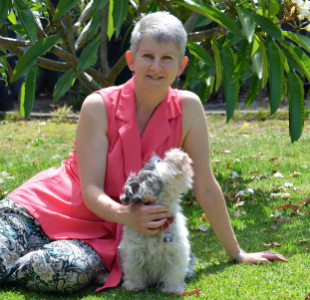 Our Giant Schnauzer puppy Lucky Chance was born in 1998. He arrived by plane at only 14 weeks old. The breeder we bought him from sent a lot of information about how to care for him. She wanted us to feed him a healthy diet and avoid future yearly vaccinations. When Chance was about 2 years old he developed severe atophic allergies. His bad seasons were spring and fall and we treated him with allergy shots.
Our Giant Schnauzer puppy Lucky Chance was born in 1998. He arrived by plane at only 14 weeks old. The breeder we bought him from sent a lot of information about how to care for him. She wanted us to feed him a healthy diet and avoid future yearly vaccinations. When Chance was about 2 years old he developed severe atophic allergies. His bad seasons were spring and fall and we treated him with allergy shots.
Chance certified with Therapy Dog International at 3 and visited a local nursing home for about 9 years. He was an active healthy and powerful dog, walking many miles a day.
In the spring of 2007 Chance had his spleen removed along with a large benign tumor. Our vet felt that he would be fine after this and he did seem to be much better.
A month or so later, after some vague symptoms, he was diagnosed with non-regenerative anemia and neutropenia.The medical term for this is bicytopenia. A bone marrow biopsy indicated that his bone marrow did not have the capability to make new red blood cells or white blood cells. The specialist he saw could not determine why this was happening and suggested only that he thought it might be autoimmune in nature. The vet prescribed prednisone and antibiotics.
 Kahlu was born July 2006. He was to become my agility champion, I wanted to take him to many trials maybe even Nationals. Hopes and dreams. But most of all he was to be my buddy and a family pet. At 1 ½ Kahlu competed in his first agility trials and got his first titles. He got also certified as a Therapy dog and we made weekly visits at a senior’s home.
Kahlu was born July 2006. He was to become my agility champion, I wanted to take him to many trials maybe even Nationals. Hopes and dreams. But most of all he was to be my buddy and a family pet. At 1 ½ Kahlu competed in his first agility trials and got his first titles. He got also certified as a Therapy dog and we made weekly visits at a senior’s home.
Kahlu came with his first shots and, wanting to protect this precious puppy, I took him to our trusted vet who did all the scheduled boosters for core vaccines (parvo & distemper) at 12 & 16 weeks and then again after a year. At 24 weeks he got his first rabies shot. When Kahlu was one, the vet suggested that besides the core vaccines it would be good if Kahlu would also get bordatella and leptosporosis. An other year later, all the vaccinations were boosted and the vet recommended adding vaccinations for Lyme disease and giardia. Kahlu was such an athletic and healthy pup and I wanted to keep it that way, so the immunizations were done, all on the same day.
Three months later, when Kahlu was just 2 ½, I noticed he was less energetic and did not eat well. A few days after that he threw up and seemed dizzy. We took him to the vet immediately. A check of the gums showed that he was anemic. The vet cornered Kahlu and tried to take blood from a front paw. Kahlu felt threatened and squirmed out of my hold. The vet gave up and said there is no way to take blood from this dog. He sent me home with a pamphlet about Addison’s disease, shaking his head saying that Kahlu would not die tonight and I should call back tomorrow.
 Bingo is a mixed terrier, I suspect mainly Maltese Shih tzu, with possibly something else.
Bingo is a mixed terrier, I suspect mainly Maltese Shih tzu, with possibly something else.
In about October 2011, I started to become a bit concerned about Bingo as he seemed to have slowed down a lot in the last month or so. He was supposedly 7 years old at the time, but as he’d been a rescue, I began to wonder if he may have been older. He started to have difficulty climbing stairs, couldn’t jump up on the couch or bed and just seemed slower all around.
I took him to my local vets and tests eventually revealed he was hypothyroid – “A simple problem to correct” they said and I was very relieved. We started him on Thyroxine however, he seemed to get worse. Further problems started, he was gagging a lot, and it was thought possible megaoesophagus, later he became quite lame and would refuse to walk. This included several trips to the vet over a period of about 3 weeks. One particular morning, he wouldn’t walk at all and seemed quite ill. Back to the vets again and he had a fever. They kept him in to do a series of x-rays, ultra sounds and more blood tests, but nothing conclusive was found and it was suggested that I take him to an internal specialist.
Bingo ended up staying at the specialist hospital for 10 days. He was diagnosed with immune mediated disease – thyroid polyarthropathy – a multiple joint arthritis. I went home with a very quiet, lethargic Bingo, with a list of instructions and so many medications I was terrified. I was to bring him back in for check-ups 3 times a week over the first few weeks. His discharge summary showed a PCV of 22% at this time. On the second-check up his PCV had dropped to 15% and the diagnosis was now polyarthropathy and likely immune mediated anaemia (bone marrow failure). A further drug was added, Cyclosporine.
 Sadie is a beautiful, almost four year old, jet-black, female Cocker Spaniel, born June 14, 2009, living in Tampa, FL. On Friday, March 29, 2013, Sadie collapsed. We immediately went to the vet, where they did a full panel CBC and an in-house PCV. Her PCV was 21. Her gums were almost white and her tongue was ash colored. My mind was spinning with questions and my heart was crushed.
Sadie is a beautiful, almost four year old, jet-black, female Cocker Spaniel, born June 14, 2009, living in Tampa, FL. On Friday, March 29, 2013, Sadie collapsed. We immediately went to the vet, where they did a full panel CBC and an in-house PCV. Her PCV was 21. Her gums were almost white and her tongue was ash colored. My mind was spinning with questions and my heart was crushed.
Thankfully, Sadie’s vet was familiar with her symptoms and after an extensive exam, she was diagnosed with AIHA. He immediately gave her a shot of prednisone and started her on a regiment of 40mg Prednisone daily, Doxycycline, PetTinic and Pepcid (for her tummy), daily. Ten days later, we changed from Doxycycline to Baytril and added 50mg Atopica (cyclosporine) daily. Shortly after, we added Sucralfate (in place of the Pepcid). Additionally, we later added Plavix to protect against inappropriate clotting.
Three weeks after her collapse and diagnosis her PCV was 32 and it was determined that we should start weaning her off the Prednisone, as she beginning to show some bad side effects; heart murmur, muscle atrophy. It was an aggressive decrease, – 50% -, from 40mg to 20mg daily.
Sadie’s PCV started to drop and on the last five day dose regiment she RELAPSED and collapsed again. Her PCV was 24 and we were back at square one – 40mg of Prednisone and 50mg of Atopica. Her palsy had also moved from her right side to her left side.
When Sadie’s PCV rose to 44, we again began wean the Prednisone. BUT this time – VERY, VERY SLOW. The reductions on the Prednisone were in increments of 25% per month. We did weekly PCV’s and monthly CBC’s to check blood levels and ALWAYS constantly checked her mouth for pink tongue and gums!